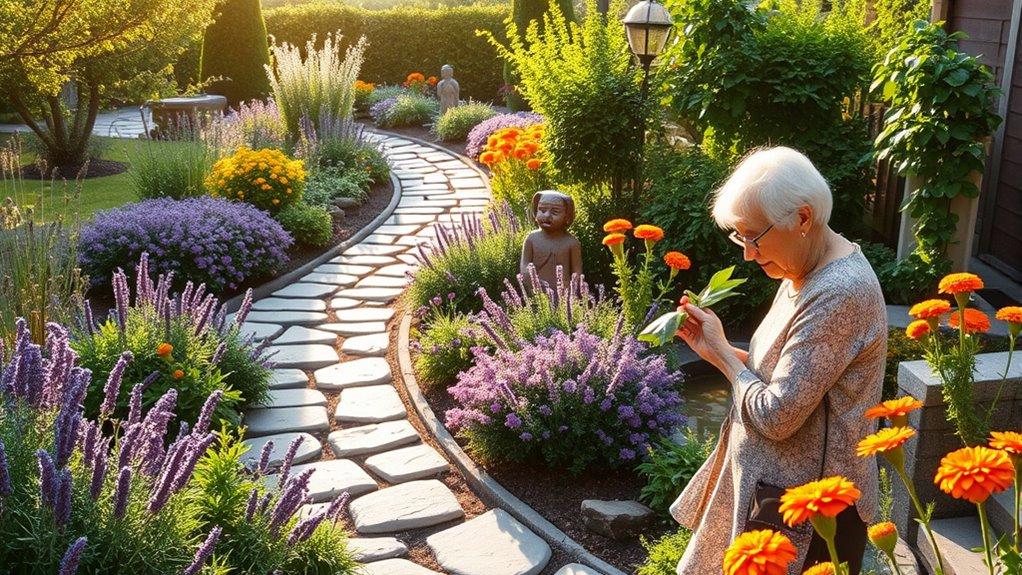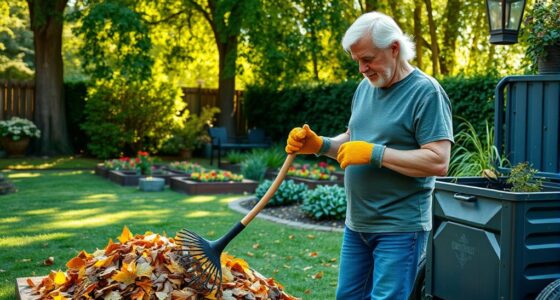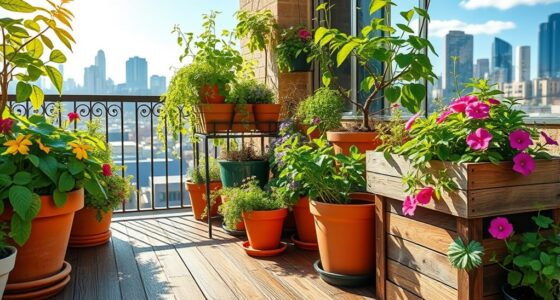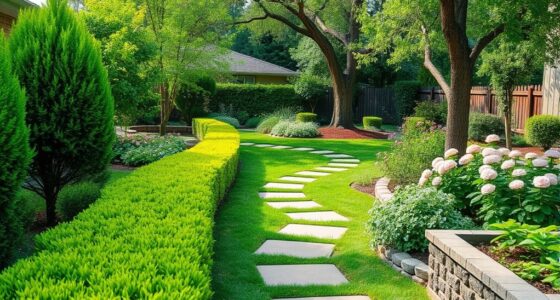Sensory gardens provide a therapeutic outdoor space where you can engage your senses and boost well-being. They feature fragrant plants, textured foliage, colorful flowers, and soothing water sounds to stimulate sight, smell, touch, and hearing. Designed for accessibility, these gardens often include wide pathways, raised beds, and calming features that encourage exploration and relaxation. Continuing your journey will reveal how thoughtful design creates a peaceful environment that supports both your mental and physical health.
Key Takeaways
- Sensory gardens promote mental and physical well-being for seniors through multi-sensory engagement and exploration.
- Thoughtful garden design includes fragrant, textured, and colorful plants to stimulate all senses safely.
- Accessibility features like wide pathways, raised beds, and seating ensure easy navigation and participation.
- Lighting and natural elements enhance safety, extend usability, and create a calming environment during evenings.
- Integrating safety, aesthetics, and sensory elements fosters therapeutic benefits and encourages outdoor activity for seniors.

Sensory gardens for seniors offer a vibrant, calming space that stimulates the senses and promotes well-being. When designing these gardens, paying careful attention to garden design is vital to create an environment that encourages exploration and comfort. You want to consider how different elements come together to engage multiple senses, from sight and sound to touch and smell. Thoughtful placement of plants, textures, and features can make the garden accessible and inviting, allowing seniors to enjoy its benefits fully.
Designing sensory gardens for seniors enhances well-being through engaging multiple senses in a welcoming environment.
Start by selecting a variety of plants and features that provide rich sensory stimulation. Incorporate fragrant flowers like lavender, rosemary, or jasmine that fill the air with pleasant scents. Use textured plants such as lamb’s ear or succulents for touch, giving seniors the chance to feel different surfaces and textures. Brightly colored flowers and foliage can enhance visual appeal, while water features, wind chimes, or bird feeders introduce soothing sounds that add an auditory dimension to the garden experience. These elements work together to create an engaging environment that encourages seniors to explore at their own pace. Additionally, incorporating a variety of sensory-rich plants can further deepen the sensory experience. Incorporating multisensory elements can heighten therapeutic benefits by engaging multiple senses simultaneously.
Designing for accessibility should be a priority. Use wide, flat pathways to guarantee easy navigation, especially for those with mobility aids. Incorporate raised beds or accessible planting areas to enable seniors to participate actively in gardening activities if they wish. Seating options placed throughout the space provide places to rest, observe, and enjoy the sensory stimuli. Shade structures or pergolas can offer shelter from sun and rain, making the garden usable in different weather conditions. By combining functionality with beauty, your garden design assures that seniors feel comfortable and motivated to spend time outdoors. Additionally, incorporating universal design principles can further enhance accessibility and safety for all users.
Lighting also plays a vital role in enhancing sensory stimulation. Soft, warm lighting can highlight key features and create an inviting atmosphere during the evening hours. Consider installing solar-powered lights along pathways or around focal points to improve safety while adding a gentle glow to the space. Additionally, integrating natural elements like stones, driftwood, or textured sculptures can further stimulate tactile senses and add visual interest. Understanding how sensory input influences perception can help you craft a more engaging environment for seniors. Moreover, using proper lighting techniques can help reduce shadows and glare, making the space safer and more comfortable. Thoughtful lighting design can also extend the usability of the garden into evening hours, promoting longer engagement.
Creating a sensory garden for seniors is about more than just plant selection; it’s about designing an environment that nurtures curiosity, relaxation, and engagement. Every element should contribute to a cohesive experience that appeals to the senses and promotes mental and physical well-being. When you thoughtfully blend garden design principles with sensory stimulation, you craft a therapeutic outdoor space that can greatly enhance seniors’ quality of life and foster a sense of peace and connection with nature. Additionally, understanding best garden design practices can help optimize the therapeutic benefits of these spaces. By prioritizing safety features and clear pathways, you ensure that the garden remains accessible and enjoyable for everyone.
Frequently Asked Questions
How Can Sensory Gardens Be Customized for Individual Seniors?
You can customize sensory gardens for individual seniors by focusing on personalized plant selection that suits their preferences and needs, such as fragrant flowers or textured leaves. Incorporate adaptive sensory tools like raised planters or tactile panels to enhance accessibility and engagement. By tailoring these elements, you create a calming, stimulating environment that promotes relaxation and sensory exploration, making the garden truly meaningful and enjoyable for each senior.
What Maintenance Is Required for Sensory Gardens?
You’re really in the driver’s seat when it comes to maintaining a sensory garden. Regular tasks include watering, pruning, and replacing seasonal planting to keep it lively. Check garden furniture for wear and tear, and clean it regularly. Mulching helps retain moisture and control weeds. With a bit of effort, your garden stays inviting and vibrant, proving that a well-maintained space truly blooms with care and attention.
Are Sensory Gardens Suitable for All Mobility Levels?
You might wonder if sensory gardens suit all mobility levels. The answer is yes, especially when they include accessibility features like ramps, wide paths, and seating. Using sensory stimulation techniques such as varied textures, scents, and sounds, you can enjoy the garden regardless of mobility. These adaptations guarantee everyone can explore and benefit from sensory experiences, making the space inclusive and enjoyable for all users.
How Do Sensory Gardens Impact Seniors’ Mental Health?
You might think mental health isn’t affected by a simple walk outside, but you’d be wrong. Sensory gardens boost seniors’ emotional well-being by strengthening their connection to nature. As they engage their senses, they find peace, joy, and purpose. This natural therapy helps reduce anxiety and depression, proving that sometimes, the best medicine is a little fresh air and a touch of nature’s beauty—truly a gift for emotional health.
What Safety Measures Are Essential in Sensory Garden Design?
You should prioritize safety by installing adequate garden lighting to prevent trips and falls, especially at night. Use pest control measures to keep insects away, guaranteeing a comfortable environment. Select non-slip surfaces and remove any hazards like sharp tools or uneven ground. Regularly inspect the garden for potential risks, and ensure pathways are wide and accessible. These steps help create a safe, enjoyable outdoor space for everyone.
Conclusion
Creating a sensory garden for seniors is like planting a treasure chest of experiences. It engages their senses, lifts spirits, and fosters connection with nature. As you nurture these outdoor spaces, you give seniors a sanctuary where they can find peace, joy, and renewed vitality. Embrace the beauty of sensory gardens, and watch how they become a vibrant, healing haven—like a gentle breeze that refreshes the soul and renews the mind.









